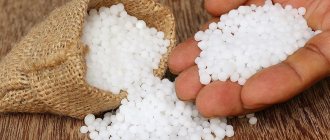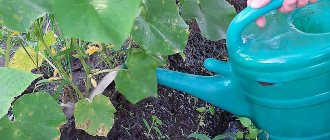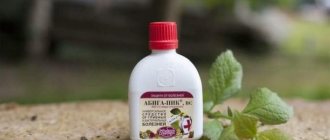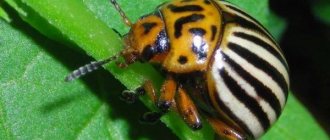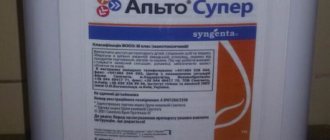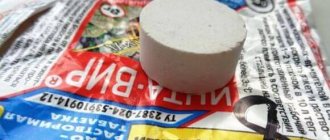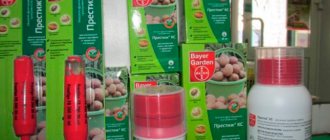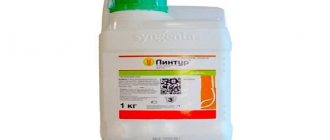Home / Preparations and fertilizers
Back
Published: 09/26/2021
2
5/5 — (1 vote)
Many summer residents have to grow vegetables in infertile areas. To enrich the soil, various methods and means are used, among which is potassium humate.
Thanks to organic fertilizer, they not only increase the natural fertility of the soil, but also accelerate plant growth and shorten the harvest time. The result is visible only with proper application of fertilizing, otherwise it is easy to harm the crops.
- 1 Composition and characteristics
- 2 What is it used for?
- 3 Types of potassium humate
- 4 Instructions for use
- 5 Analogues
- 6 Compatibility
- 7 Storage rules
What is Potassium Humate
Potassium humate is an organic fertilizer that is naturally formed in the soil as a result of the decomposition of animal and plant organisms (foliage, stems, fruits, insects, worms and others). From a chemical point of view, it is an organic potassium salt of an unstable structure. This is not one substance, but a whole mixture of components of different structures.
Initially, humic acids are formed in the soil. They are the ones that give the soil its characteristic black color. But they are not used in their pure form - plants absorb salts well, not acids - potassium and sodium humates. To obtain these substances, acids are neutralized industrially with alkalis, for example, caustic soda (sodium hydroxide).
At the same time, humic acids themselves are not synthesized, but are taken from the soil - mainly from the following fractions and rocks:
- peat;
- brown coal;
- sapropel;
- leonardite.
The resulting product is crushed and sent to dry, and then packaged. There are several forms of release:
- Humate tablets are complex fertilizers, which, along with humins, also contain classical microelements (nitrogen, phosphorus, potassium);
in granules. For summer residents and farmers, fertilizer is sold in various packages (capacity from 10 g to 20 kg);
- liquid peat potassium humate.
The solution is added to the required amount of water according to the instructions.
Manufacturers produce several drugs:
- “Prompter” is a universal-purpose humate, which is produced in liquid form in containers of 250, 500 ml and 10 liters. The product helps drying plants that do not take root well after being transplanted to a new location.
- “Barrel and four buckets” - available in bottles of various dosages, as well as in the form of tablets for use over a large area - both on a personal and on a farm.
- “Biud” - restores soil fertility, removes heavy metals from the soil, increases plant resistance.
- “Sakhalinsky” is a powerful growth stimulant, recommended for use in the Far East, Siberia and other regions with an unfavorable climate.
Types of drugs: composition and characteristics
The list of the most effective and popular fertilizers based on potassium humate is discussed in more detail below.
Universal
Universal potassium humate has a beneficial effect on plant growth, reduces soil acidity and accelerates metabolic processes. The fertilizer has the following composition:
- a large number of humic compounds;
- substances that are growth stimulants, peptides;
- wax, fat, antibiotics;
- essential amino acids and enzymes.
Potassium ensures the normal process of photosynthesis, sugar formation and the entry of carbohydrates into the plant. Mineral fertilizer can be used to treat seeds, cuttings, and adult crops when using a certain concentration of the product.
Fertilizer must be applied directly to organic compounds, since when planted in black soil, the solution will not have the desired effect.
Liquid peat
Liquid peat humate has a considerable number of positive reviews regarding the degree of effectiveness of the product. Dark brown liquid with a high content of active compounds (up to 80%) and natural peat.
The composition also contains essential minerals and organic substances. The fertilizer is easy to use and quickly gives the desired effect:
- Fertilization of plant crops is carried out with a solution with a concentration of no higher than 0.01% (soaking seeds, planting, fertilizing, spraying on the top part);
- improvement of the general condition of the soil with a solution of 0.2%;
- the drug can be used in combination with pesticides, nitrogen fertilizers, and organic compounds; the exception is phosphorus compounds, since when mixed with potassium they form insoluble substances;
- the use of fertilizer in an integrated crop care scheme ensures an increase in yield and helps reduce the use of various nitrates and toxins.
Peat powder
Peat humate powder dissolves well in water and forms a suspension of useful minerals. Advantages when using:
- increasing germination and further growth of planting material;
- stimulation of the root system;
- strengthening immune functions;
- increase in fruiting time;
- shortening the ripening period and reducing the content of nitrous acids in the soil.
Expert opinion
Stanislav Pavlovich
Gardener with 17 years of experience and our expert
Ask a Question
When applying fertilizer, the quality of humus increases, which improves biological activity and increases the yield of cultivated crops.
The drug "Reichard"
A fertilizer mixture with a balanced composition that increases soil fertility and allows you to grow environmentally friendly crop products. Scope of application (processing, fertilizing of grain, industrial, fruit and berry, garden and greenhouse crops in open and closed ground).
Advantages when using:
- improving the process of nutrient absorption;
- natural soil fertility and increased growth;
- increased resistance to various diseases and pests;
- increasing productivity.
Fertilizer mixture “Prompter”
The popular mineral fertilizer mixture “Prompter” contains a complex of useful substances and compounds that provide a certain effect on soil improvement:
- increasing immunity;
- accelerating the process of growing seeds and ripening fruits;
- rapid adaptation of the plant when weather conditions change;
- affordable price (in the range of 90 rubles);
- restoration of severely depleted soil.
See also Scheme for pruning cucumbers in a greenhouse and open ground
Potassium humate with trace elements
A concentrated fertilizer solution that can increase soil fertility by 40% and yield by 30%. The consumption rate is 0.4 liters per 1 hectare of land. The main components of the composition (humic compounds, lignin, pigments, amino acids, biologically active substances) ensure the biological activity of the soil.
Pros of use:
- improvement of physical, chemical, biological properties of soil;
- increasing productivity and soil fertility;
- plant resistance to adverse environmental factors (diseases, pests, harsh weather conditions);
- reducing costs in farming as an alternative to using potassium humate as a cheaper and more effective means.
"Energen"
A natural growth stimulator in the form of polydisperse granules that dissolve well in water. Composition of the drug:
- humic, fulvic, silicic acids;
- complex of mineral compounds.
Application area:
- spraying, soaking seeds, seedlings, seedlings, tubers;
- treatment of plants outside the root;
- watering and spraying crops;
- joint use with pesticides, water-soluble fertilizer mixtures.
“Prompter” from “Oktyabrina Aprelevna”
“Prompter” from “Oktyabrina Aprelevna” is a mineral fertilizer that is intended for garden flowers and contains a complex of humic compounds and other useful microelements.
Advantages when using:
- eliminating yellowness of leaves;
- increasing resistance to various diseases and pests;
- increasing the number of flowering buds.
Expert opinion
Stanislav Pavlovich
Gardener with 17 years of experience and our expert
Ask a Question
When fertilizer is applied, garden crops tolerate the winter well. Area of application (soaking, planting seeds, spraying, watering flowers during their growing season, combined use with other fertilizers).
"Humate + 7 iodine"
The composition “Humate +7 iodine” has an improved composition with a maximum content of humic compounds (up to 85%) and the necessary mineral additives (manganese, molybdenum, zinc, boron, nitrogen, iodine, iron).
Release form – dry granules intended for dissolution in water and used for treating the upper part of plants during the growing season. The proportion for preparing the solution is 100 grams of the substance per 10 liters of water.
Fertilizer composition Potassium humate
The composition of universal potassium humate includes the following components:
- humic acids – 80 g/l;
- nitrogen compounds – 20 g/l;
- potassium compounds – 5 g/l;
- phosphates – 2 g/l.
Microelements are present in insignificant amounts (total 0.02 g/l):
- iron;
- copper;
- boron;
- cobalt;
- zinc;
- manganese.
The color of the mixture is dark brown, brown or black. The acidity index (pH of the environment) is 6.8 (slightly acidic, close to neutral 7.0).
How to improve efficiency?
The experience of recent years has shown that it is more effective to use humates not as fertilizers, but as a complex action product. And timely stress relief further enhances the effect of feeding. If you rely on relieving stress and stimulating growth, then you should take advantage of all the possibilities available to science. Stress results in stunted growth. Therefore, the task is somewhat simplified. It all comes down to driving growth. Farmers know that phytohormones best stimulate growth. The main thing is to choose the right combination and provide the plant with nutrition. If the plant does not have the resources necessary for growth, treatment with phytohormones will not lead to anything good. The Normat L preparation contains humic and fulvic acids and other important substances - that is, a comprehensive set of nutrients (including microelements), and in an easily digestible form. And this healthy “cocktail” is complemented by microdoses of phytohormones. If Normat L is used together, for example, with pesticides, then at the first moment phytohormones help the plant continue to grow. They act quickly. Then humic substances are added to them. They are also quickly absorbed and help the plant recover from stress. After some time, growth again occurs due to its own phytohormones, and the beneficial substances introduced by Normat L help maintain this growth. Likewise, the phytohormones in Normat C help awaken the seeds. Soaking in a Normat C solution not only “awakens the seeds” and increases germination, but also provides them with a set of nutrients “for the first time.” Is it really so important that the seeds will sprout, as if on command, earlier than usual, and the sprouts of cultivated plants will appear from the ground before the weeds? Is it really so important that they will have more developed roots and, accordingly, increased resistance to frost and drought? Decide for yourself...
What is the difference between potassium humate and sodium humate?
Potassium humate and sodium humate are salts of humic acids obtained during the processing of raw materials with the appropriate alkali. These fertilizers are very similar in composition, but slightly different in properties. Potassium is an important nutritional element, and sodium is an antagonist that interferes with its absorption.
Sodium humate is a cheaper analogue, but at high concentrations in the soil it increases toxicity
| comparison sign | Potassium humate | Sodium humate |
| properties | increasing productivity, increasing germination strengthening the root system | increase in green mass growth increasing resistance to harmful factors preventing flowers and leaves from falling |
| application | soil fertilization | – |
| soaking seeds | ||
| feeding during budding, flowering and fruit set | ||
Main components of potash fertilizer
The name “potassium humate” refers to a complex of organic and mineral fertilizers, the effectiveness of which is scientifically proven. Thanks to its balanced composition, the drug has a gentle effect on the soil and crops. The presence of humic acids (75-80%) accelerates the development of most plants. When added to soil, the product helps normalize soil acidity and improve quality characteristics. Fruit and vegetable crops, garden and ornamental plants receive adequate nutrition.
This effect is due to the composition of potassium humate:
- amino acids;
- peptide amide bonds;
- enzymes;
- growth activators;
- substances that inhibit microbial growth.
Humic acids stimulate metabolic and biochemical processes in the soil. To obtain high molecular weight organic substances, brown coal, peat or lignosulfonates are used. In addition to fertilizing the soil, the drug is used for pre-sowing treatment of seeds, seedlings, seedlings and when transplanting adult plantings.
Please note: the bulk of nutrients are obtained by processing oxidized drill coal. This is due to the content of 85% humic substances in its composition. Fertilizing is carried out in two forms - without and ballast.
What is good about potassium humate?
The main beneficial property of this fertilizer is a significant acceleration of plant development. Thanks to the activation of metabolic processes in tissues, the use of Humate leads to effective consequences:
- rapid collection of green mass;
- accelerated fruit set and early ripening;
- increasing productivity up to 50% of the norm (subject to other care rules);
- improving resistance to diseases, pests and adverse external conditions;
- formation of a developed root system;
- acceleration of chlorophyll synthesis, which provides plant nutrition, saturation with vitamins and nutritional components.
The product works especially well on depleted soils.
Fertilizing helps restore natural fertility and ensures a balance of acids and alkalis
In addition, Humates are the main vital activity of soil bacteria, which also have a beneficial effect on plants.
Important! The components of the drug bind heavy metals and other toxic substances.
This is especially important for personal and farm households located near highways and industrial facilities.
Efficiency and results of using humates
The positive properties of potassium humate include accelerating protein synthesis, metabolism, and increasing the level of resistance to various diseases and toxic substances.
Benefits for the soil
The positive effect of potassium humate on soil is the formation of humus, rich in useful substances that are necessary for the normal functioning of plant crops. This technique also allows you to restore the balance of the composition of depleted soil, deprived of the supply of necessary compounds.
Benefits for plants
The benefits of mineral fertilizer for plants are based on the presence of a beneficial effect on certain stages of cultivation:
- increasing seed germination and germination;
- improving the process of rooting the root system when planting seedlings;
- obtaining a high-quality harvest and quickly growing the plant even with sudden changes in weather;
- The drug contains only safe compounds that do not have a negative effect on the human body.
What is potassium humate used for?
Fertilizing has a complex effect on the soil and plants. This product acts as a growth stimulator - it promotes the rapid growth of green mass and accelerates the ripening process of fruits. At the same time, Humate affects the soil structure, restoring the acid-base balance. Those. this drug plays the role of a growth stimulator - it is not a classic fertilizer (such as complex mineral fertilizer, superphosphate, bird droppings).
It should be borne in mind that Humate is a mixture of acids. Plants first assimilate chemically more active and “mobile” potassium (and sodium) ions, after which many Humate molecules are absorbed into the ground. If you apply them immoderately, this will inevitably lead to acidification of the soil.
That is why it is better to alternate root and foliar application methods, and also carefully follow the dosage prescribed in the instructions. For individual plants, such a medium will be optimal, for example, Potassium humate is well suited for conifers.
Attention! If it is known that the soil is very acidic (horsetails, plantains, horse sorrel grow abundantly), such fertilizers should not be given. First, you need to neutralize the environment by adding up to 30-50 kg of slaked lime per 1 hectare of garden.
Regular fertilizing with potassium humate can increase productivity by up to 50%
Yield increase mechanism
Ways to increase crop yields under the influence of humates have been studied since the end of the 19th century. Especially a lot of data was accumulated in the 60s of the last century. The works of domestic and foreign scientists indicate the multifactorial influence of fertilizers on soil and plants, manifested in the following effects:
- Increases germination and germination energy of seeds up to 100%.
- Binding of heavy metals and other toxic substances into compounds inaccessible to crops.
- The process of plant respiration under the influence of humates increases, which is expressed in an increase in their biomass.
- Root nutrition is stimulated.
- Humates help the plant absorb phosphorus, zinc, iron, and copper from inaccessible forms in which they are usually found in the soil.
- The microbiological activity of the soil increases.
- Soil particles acquire structure and retain moisture better.
All of the above effects together lead to a significant increase in yield without compromising product quality and the environment.
Norm of potassium humate per liter of water
This fertilizer is a concentrated mixture of organic substances that make up the fertile soil layer. According to calculations, 1 kg of such fertilizing will replace 1 ton of humus. Therefore, it can be added to the soil only in very small quantities. If you use the drug in liquid form, the dosage will be as follows:
- for root feeding 0.1-0.2% of the total volume of solution, i.e. only 1-2 ml per 1 liter of water;
- for foliar treatment – 0.01% of the total volume – i.e. 0.1-0.2 ml per 1 liter of water;
- for soaking seeds - 0.5 ml per 1 liter of water.
Consumption rates of the resulting solution:
- 6-8 l/m2 in open ground;
- 4-6 l/m2 indoors, as well as for indoor flowers.
Dry potassium humate powder is used less frequently for tomatoes and other crops. You can take it in the amount of 50 g per 10 m2 (or 500 g per 1 hundred square meters) and scatter it evenly over the surface, then dig up the area and water it.
To treat large areas, 2-3 bottles of the drug (1 liter each) are diluted in 1 barrel (200 liters of water). It is advisable to start processing immediately or in the coming days. The maximum shelf life (under the lid) is 1 month.
Areas of use
Potassium humate is a universal preparation used for:
- preparation of seed material;
- feeding seedlings;
- saturation of greenhouse and garden crops with nutrients;
- foliar treatment of flowering and fruiting plants;
- restoration of soil fertility;
- improving the quality of organic fertilizers.
Before adding humate, the soil is moistened. The powder solution must sit for 2 days before use.
Pre-sowing preparation
The potassium preparation is used to treat seeds and bulbs as a growth activator. It stimulates germination, makes sprouts strong and healthy.
Vegetable seeds, garlic and onions are immersed in a warm potassium solution. Leave it for a day.
Growing seedlings
Potassium humate makes young plants less susceptible to infection and pests, and accelerates adaptation to negative external factors. Treated seedlings take root faster after being transferred to an open area. The number of dead plants is reduced.
The properties most suitable for seedlings are liquid potassium preparations. It is more easily absorbed by roots from the soil. It is not advisable to use powdered humate for seedlings, since you will have to loosen the soil. And this can lead to injury to the delicate roots.
It is useful to pour potassium humate into planting holes when transferring seedlings to a permanent place. The dose is taken in accordance with the instructions.
As a fertilizer
The potassium preparation can be used to feed vegetables, root crops, pumpkins, cruciferous crops, flower crops, and potato bushes. The product accelerates plant development and increases yield by 15-20%.
It is recommended to mix humate with organic fertilizer: manure, humus, compost. For 10 kg of basic fertilizer take 10 g of potassium.
Powdered humate as a fertilizer can be applied to the soil before digging. Moreover, the substance not only saturates the soil with useful substances, but also reduces its toxicity after the use of pesticides and other pesticides.
How to dilute potassium humate
Liquid Potassium Humate with microelements is a concentrated solution, so it must be diluted in water according to the instructions:
- Pre-settle the water. If possible, it is better to use natural ones - from a well, melt, or lake.
- Measure out the required volume of the finished solution, for example, 10 liters.
- Select 0.1% of liquid fertilizer from the total volume. For 10 liters, only 10 ml of potassium humate is enough.
- Fertilizer is applied by root (watering) or foliar (spraying) method.
- At the same time, pesticides can be used (if necessary), since the use of fertilizing significantly reduces the content of nitrate salts and toxic substances in the future harvest.
Advice! It is most convenient to measure small volumes of liquid with a medical syringe.
Moreover, it is better to treat the entire area at once in order to take, for example, not 0.1 ml per 1 liter, but 1 ml per standard bucket of water (10 liters).
Humate is consumed in small quantities, so it is one of the most affordable fertilizers
Advantages and disadvantages
Potassium humate is one of the most effective, convenient and safe fertilizers. Its main advantages:
- environmentally friendly, harmless to humans and plants;
- restoration of chemical composition and improvement of soil structure;
- acceleration of fruiting by at least a week;
- increasing productivity;
- improving seed germination;
- strengthening roots;
- positive effect on the immunity of plant organisms;
- reducing plant consumption of nitrates;
- increasing the shelf life of the harvested crop;
- strengthening plant adaptation to negative environmental factors;
- Possibility of use for processing any cultural species.
Potassium humate is a completely harmless drug and only brings benefits. Plant growers do not note any negative aspects when used correctly. However, humate is not a medicine for plants, but only a fertilizer. The substance enhances the positive results of competent cultivation of cultivated plants.
Potassium humate is useless when applied to acidic soil. The soil on the site should be podzolic or alkaline. A positive result is not noticeable when using fertilizer on chernozems.
How to feed with potassium humate
The product has a universal effect, so it is used for all plants:
- potassium humate is suitable for seedlings;
- for vegetable plants;
- for fruit trees and shrubs;
- for garden and indoor flowers;
- for decorative and tall conifers.
The drug can be used in different ways:
- Root - make a solution, observing the dosage, and pour it into the hole. It is advisable to loosen the soil the day before so that the nutrients reach the roots as quickly as possible and then spread throughout the entire plant.
- Foliar - obtain the solution according to the instructions and spray. It is advisable to do this in dry, windless weather, late in the evening.
- Fertilizing the soil - mix 50 g of dry powder with the same amount of fine sand and scatter it over 10 m2 of soil. Then loosen with a rake and water. This procedure can be carried out at the end of February, i.e. Scatter the mixture directly onto the snow. In this case, there is no need to water - just cover with plastic wrap, and then, when the snow melts, dig up the area.
The feeding schedule depends on the specific crop:
- Seedlings of cucumbers, tomatoes and other plants are watered immediately after being transferred to open ground, then at the stage of bud formation and during flowering. Moreover, the concentration can be increased by diluting 1 tablespoon of the product in a bucket of warm water.
- Root crops are fed 4 times with an interval of 2-3 weeks.
- To soak planting material, dilute 0.5 g in 1 liter of water and keep the seeds for 24 hours, and the bulbs for 8 hours, and it is advisable to keep flower and cucumber bulbs in potassium humate for two days.
- To stimulate the growth of root hairs, cuttings can be lowered to 2/3 of their length overnight (12-14 hours).
- When applying Potassium Humate fertilizer for strawberries and other fruit and berry crops, the concentration is reduced - 3 ml per 10 liters of water. It is better to alternate the root method with the foliar method, and also combine the application of fertilizing with pesticide treatment.
- Potassium humate for indoor plants can also be used up to 3-4 times per season, especially abundantly at the beginning of growth (March - April).
- Potassium humate for roses and other perennial flowers is applied 4 times: in early spring, after 3 weeks, at the stage of bud formation and during flowering. In August and autumn there is no need to fertilize - the plant is preparing for a dormant period.
- Lawns, dwarf conifers, thuja and other ornamental shrubs can be treated every two weeks.
Fertilizing is applied by root and foliar methods
Important! When spraying foliage, choose clear, windless weather. You should not combine Humate with phosphorus fertilizers - it is better to alternate them with an interval of 7-10 days.
Compatibility with other fertilizers
Experienced summer residents develop a calendar of field work, preventive measures and fertilizing before the season. The schedule must specify the types of fertilizers, the number of treatments with fungicides and other preparations.
When a decision is made to use humate fertilizer during the growing season, two rules should be followed:
- It is not allowed to cultivate the soil together with phosphate fertilizers or potassium nitrate. You should pause for at least 7 days.
- Treatment of perennial plants is carried out several times a season, and annual crops only before the formation of buds.
Mineral fertilizers in combination with potassium humate preserve the structure of the soil and enrich it with humic acids.
The agrochemical can be combined with the following types of fertilizers:
- nitrogen;
- potash;
- organic.
Help: potassium humate in powder form can be replaced with high-quality humus. So, 1 kg of the drug is equal to 1 ton of soil. At the same time, fertilizing helps remove nitrates and chemicals from the fruit.
Interesting! Fertilizer potassium sulfate: use in the garden.
Terms and conditions of storage
Manufacturers claim that the shelf life of the drug is unlimited. However, it is better to use it within the next 2-3 years after manufacture. Storage is carried out at any temperature and moderate humidity. It is important to keep the powder or liquid away from direct sunlight. You should also prevent children and pets from accessing the storage area. The drug should be kept separately from food and medicines.
Attention! If the powder or liquid product is diluted in water to obtain a working solution, it can be stored in any container (under a lid) in a dark place for no more than 1 month. Remains can be poured down the drain.
Instructions for use of the prepared solution
When using potassium humate in crop production, the species of the crops being processed is taken into account.
For cereals
To soak the grain, use a liquid preparation, take 200 ml per 10-liter bucket. Many farmers prefer to use special formulations based on humates to treat seed.
The spraying method is used to feed grain crops. Optimal processing times:
- rye, wheat, barley, oats - in the tillering phase and the beginning of flowering;
- sorghum and millet - when the first flowers appear;
- buckwheat - during the budding phase and half a month after it;
- corn - at the stage of opening the first leaves and flowering.
For vegetables
Vegetables are processed 2-6 times during the growing season.
For watering, take 50-100 ml of concentrate per 10-liter bucket. 5-10 liters are spent per 1 m2. For foliar treatment, a similar solution is used. But 1.5-3 liters are spent per 1 m2.
How can I replace potassium humate?
Potassium humate can be replaced with humus, compost, bird droppings and other natural organic fertilizers. You can also use various growth stimulants instead, for example:
- Epin;
- Heteroauxin;
- Immunocytophyte;
- Kornevin;
- Krezacin and others.
Reviews of humic fertilizers
Since humate is a very common fertilizer, it is not surprising that there are many reviews on it. But almost all gardeners talk only about the positive effect of humate on vegetable crops.
If you do not overdo it with fertilizing and follow all the proportions specified in the instructions, then humate is simply irreplaceable in its field. Summer residents note that after the first application of fertilizer, plants take on a healthier appearance and begin to grow much faster.
On the Internet there are several tens of thousands of positive reviews of humate from both amateur gardeners and gardeners who grow their plants on an industrial scale.
Humic fertilizer also copes with the problems of depleted soil with a low content of microelements. The product fills the soil with useful substances and makes it much more fertile.
Buyers appreciate the naturalness of humate, because it is produced only from natural raw materials, without the addition of chemicals. The fertilizer does an excellent job of removing pesticide residues and heavy metals from plants, which is especially good in our environmental conditions.
If you have never encountered humic fertilizer before, then it is never too late to start this acquaintance. We are confident that you will be satisfied with the results obtained from using the humate.
Kinds
Humates come on sale in liquid form in the form of concentrates, in the form of powder or granules, in the form of pastes and gels. Any form of the drug has the same effectiveness if high-quality raw materials are used in production and the production technology is maintained.
Liquid humates
Liquid concentrates are purchased, as a rule, by owners of dachas and small plots of land. It is convenient to fertilize liquid formulations and indoor plants when a small amount of fertilizer is required. Such drugs are consumed gradually and slowly throughout the season.
From an economic point of view, it is advantageous to use a paste, the dilution of which produces a large amount of concentrate. More recently, humate appeared on sale in the form of a gel. Such compositions produced using new technologies are characterized by high molecular activity. In terms of effectiveness and methods of use, they are similar to pastes.
Liquid potassium humate is a concentrate. For use it is diluted with water. The proportion of water is determined depending on the purpose of use. So, to improve the condition of the soil, a solution containing 0.2% liquid humus is made. If the fertilizer is used for watering, soaking seeds or spraying, make a solution containing 0.01% liquid humus relative to the total volume.
If we consider sodium humate in application, it should be said that initially it is a bulk material. But here you should know that dry humic acids are poorly soluble in soil and therefore poorly absorbed. If the drug is considered as a growth stimulant, it is better to use liquid sodium humate. The concentrate is diluted with water according to the instructions (it can always be found on the packaging of the drug).
Dry humates
Humates in dry form are convenient because they can be applied to the soil either in bulk or in diluted form. Owners of large farmlands prefer to use bulk fertilizer, since applying a liquid composition is more problematic.
Dry potassium humate
Dry humate, getting into the soil, accelerates the development of microflora in it and the formation of good humus. In cases where watering of plants is required to strengthen their immunity, humus powder is diluted in water. The proportional ratio of powder and water is indicated in the instructions.
Vegetables and humus supplements
With constant use of a personal plot, the soil is depleted. Additional use of organic matter is required, for example, manure or humus, but it is much more cost-effective to use concentrated humic fertilizers.
They are also made from organic matter, but are much cheaper and more cost-effective. If it takes time for organic components to rot, then potassium humate for feeding cucumbers acts immediately after application to the soil.
When using potassium humate for any vegetables, rapid development of seedlings and accelerated appearance of flower stalks and ovaries are observed. The climatic conditions of the region have little effect on losses during fruit filling.
Various natural mixtures of humic additives are suitable for all types of soil: sandstones become more viscous, and clay allows air and moisture to pass through better. We can say that this is a universal preparation for all garden plants.
For acidic soils, “Prompter” is suitable, the pH of which is 10. This neutralizes the acid. If the soil has not been looked after for a long time and only mineral additives have been used, then it is recommended to use humates - sodium, ammonium, potassium - in the first year to restore fertility. Next year the harvest will be much higher.
For neutral and slightly acidic soils, it is necessary to use a neutral humic fertilizer, the pH of which is 7 - 7.5, so as not to alkalize the soil, otherwise the absorption of phosphorus will be impaired.
Spraying and watering
This method is good because you don’t have to run around with a bucket among the beds, and the solution consumption is reduced. All you need to do is walk around the garden with a sprayer. In this case, no more than three grams of fertilizer is required per ten liters of water.
Important! Carefully filter the water, as it may contain many small particles of peat, which can immediately clog the spray nozzles of the same “Beetle”
As for watering, they are carried out three times with an interval of two weeks. The treatment period should coincide with the time of intensive growth. First, there should be at least half a liter of solution per plant, and then the volume is adjusted to a liter (for the third treatment).
For convenience, it is better to water the seedlings immediately after planting them in open ground, then repeat the treatment while setting buds, and water the plants a third time during their flowering. In this case, the concentration should be increased: a tablespoon of the substance is taken per bucket of water (ten liters). Here's how to use potassium humate.
Price
Potassium humate preparations are inexpensive, it all depends on the form and packaging. The price of powdered fertilizer in a 1 kg bag ranges from 25 to 35 rubles. The cost of liquid potassium humate per 1 liter is from 80 to 150 rubles. These figures are also influenced by the company producing this fertilizer. The drugs are valid for two years, but in practice their activity lasts up to 5 years.
Reviews from gardeners and gardeners about potassium humate indicate that after application to the soil, earthworms return to it. This becomes possible due to the increase in soil nutrition. As a result of systematic use, the soil becomes loose and absorbs water well.
Correctly applied humic preparations can solve a lot of agrotechnical problems. They are successfully used on personal plots and garden complexes. The fertilizer is well-deservedly popular because it does not harm the environment, is affordable, comes in convenient forms and has clear instructions.
How to properly prepare working solutions?
For the material required for planting, you need to prepare a solution that includes 2-3 g of potassium humate and 1 liter of water at room temperature. Seeds, bulbs and cuttings are left in the composition for 12 hours.
To spray potatoes and other crops, you need to mix 3 g of potassium humate and 10 liters of veininess. Let the mixture brew for 24 hours, then strain through cheesecloth. Only after this can spraying be carried out.
To water tomatoes and other vegetables, you need to mix 22-35 g of agricultural product with 9-11 liters of water. The drug is used to eliminate harmful substances after treatment with pesticides.
Is it suitable for all crops?
Experienced gardeners know that there are no truly universal fertilizers. So is this remedy as good as we just talked about it? Let us assure you right away: today there are no crops that would react negatively to humate. Almost always, the effect of its use is closely related to the characteristics of the soil on which your garden stands.
Note that fertilizers of this type are extremely useful on soils that contain very little iron. In addition, fertilizing with potassium humate is useful on alkaline (especially on them), saline and podzolic soils. But pouring a solution of the product onto black soil is pointless, since you still won’t notice any special effect. In addition, agronomists have identified several crops that respond particularly strongly to the addition of this substance to the soil:
- All nightshades respond well (including potatoes and tomatoes), as well as beets (and fodder too).
- Almost all grains show significant increases in yield.
- Legumes practically do not change the indicators in any way.
- Under normal conditions, sunflower and pumpkin do not react to potassium humate; its use is not advisable.
It is no coincidence that we emphasized that the latest plant species do not grow under “normal” conditions. If it's been a bad year or you've planted them in poor quality soil, humic acids can work wonders! In a word, you should experiment for yourself, making sure of the effectiveness (or ineffectiveness) of this product in the conditions of your garden.
Thus, potassium humate is still universal. Its use can be recommended in almost any cases. You can read about when you should not use it at the end of our article.
The role of humic acids in plant development
Humic substances have a positive effect on all living organisms in nature, not only plants. A person who eats fruits grown using humic fertilizers receives a lot of useful microelements in an easily accessible form, since acids are formed with the participation of metals - potassium, sodium, molybdenum, iron, as well as sulfur, boron, magnesium, manganese.
To understand what potassium humate is, you need to imagine a metal ion in an organic shell created by soil bacteria. Thanks to it, plant tissues quickly absorb nutrients, since they are organic in nature. Unlike mineral fertilizers, which are absorbed by 30%, humates are completely absorbed by the root system and leaves.
Folk fertilizers for tomatoes
In addition to purchased drugs, you can also use fertilizers you make yourself. But they need to be fertilized after the seedlings have been moved to the garden. For self-prepared fertilizing solutions, slurry, mullein or chicken droppings are most often used. But not in its pure form, but with the addition of feeding drugs in small quantities. Such mixtures provide an excellent effect for the growth and development of tomatoes.
It is best to prepare and apply nitrogen-containing or potassium fertilizers. This is cow manure and nitrophoska mixed in a bucket of water.
Another good feed would be chicken manure and potassium sulfate.
It is good to use fresh manure with yeast and ash (wood), mullein and boric acid infused in water for root watering.
While the plant is blooming, you can add an infusion of ash and water mixed with potassium humate.
The easiest way to fertilize tomatoes is to mix yeast and sugar, and after three days of fermentation, add wood ash. The use of such baits gives a good tomato harvest and fills the plant with useful elements.
Any fertilizing must be applied carefully, in small quantities, so as not to burn the plant and its roots.
https://galicina.com.ua/ru/kak-pravilno-i-zachem-ispolzovat-gumat-kaliya-dlya-tomatov/https://repka.online/ovoshhi/tomaty/preparatyi-i-podkormki/gumat- kaliya.htmlhttps://7ogorod.ru/pomidory/gumat-kalia-dla-rassady-tomatov.html


